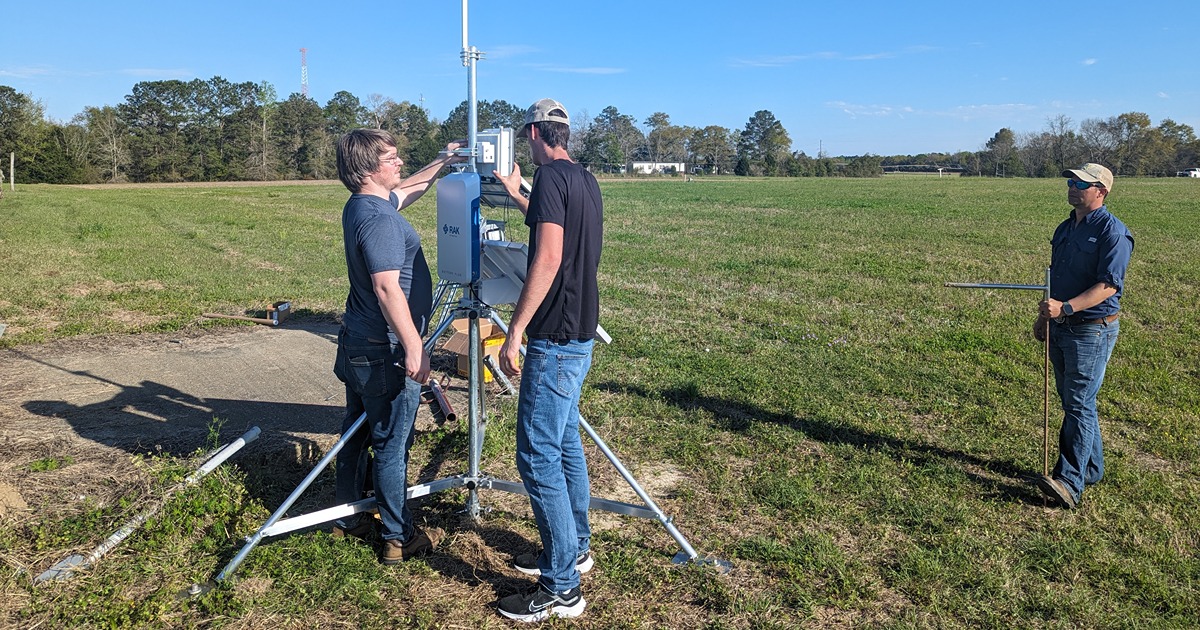IoT4Ag Center is advancing data collection capabilities for rural farms
 From left, Andrew Balmos, Josh Bailey and Derek Hurley install a device to the top of their SPRING tripod. This system collects data from sensors placed across a field to help farmers and researchers review real-time data from their fields or orchards for management decision-making (Photo provided by Purdue University/IoT4Ag).
From left, Andrew Balmos, Josh Bailey and Derek Hurley install a device to the top of their SPRING tripod. This system collects data from sensors placed across a field to help farmers and researchers review real-time data from their fields or orchards for management decision-making (Photo provided by Purdue University/IoT4Ag). WEST LAFAYETTE, Ind. — The Internet of Things for Precision Agriculture Center (IoT4Ag), now entering its fifth year, is paving the way for affordable technological innovations that help producers make informed management decisions by collecting data across farms in a low-power, long-range approach with the Solar-Powered Remote IoT4Ag Network Gateway (SPRING) project.
The National Science Foundation has funded IoT4Ag to connect cross-disciplinary scientists from four institutions — the University of Pennsylvania, Purdue University, the University of California, Merced, and the University of Florida —to each other as well as to farmers and industry partners.
The Internet of Things, or IoT, focuses on building connections. Think of how your phone has Bluetooth, which allows it to play music over your car speakers. Or, if you have a smart home, you might be able to check that you closed the garage door before you left from your work computer. The ability of these devices to work together is IoT.
Although agriculture has many high-tech elements, it lags behind many industries in regard to IoT. Rural areas lack access to internet and cellular connections, and the large initial cost of new technologies can make them difficult for growers to adopt. But in the face of climate change, a growing need for traceability and rising costs of production, farmers need IoT now more than ever to gather and access data that informs their daily and long-term management decisions.
IoT4Ag managing director Bob Brier, of the University of Pennsylvania, said center director Cherie Kagan founded IoT4Ag to help adapt agriculture to the “grand societal changes and needs regarding food, energy, agriculture and water conservation.”
The SPRING project built on IoT4Ag’s Purdue OATS DataStation (POD) project, which used long-range wide area networks (LoRaWAN) mounted on tripods placed in between crop rows to pull data from sensors across fields. Producers could travel to or virtually connect to the POD(s) to collect soil moisture, weather, grain bin status and other data.
With new advancements, SPRING uses the same LoRaWAN to collect data, but it offers a truly remote possibility using solar-powered batteries. As long as each LoRaWAN tripod can access the internet — via cell modem, Wi-Fi or wired internet connection — it will send data collected from across the farm to the cloud so that producers can access it in real time on their phones and computers.
Purdue’s Andrew Balmos, a lead software and data engineer on the SPRING project, said that unlike other cloud-based software, SPRING was designed with privacy in mind: “We’ve built an open-source code, and we are making an open-tutorial paper. They teach the user how to bring up the software in their own accounts, like on Amazon's cloud. But farmers are still fully in control of their own data, just like they were with POD.”
The IoT4Ag center is developing new low-cost sensors, and SPRING is increasing the accessibility of such technology by using hardware that is available commercially. To save money, farmers can purchase the parts and assemble setups themselves.
“Right now, SPRING setups only exist on research farms,” said Dennis Buckmaster, a professor of agricultural and biological engineering at Purdue and an IoT4Ag thrust leader. “But anyone could just replicate these designs on their own and control their data. I think the key power of SPRING is that it’s a gateway to getting more sensor data almost regardless of location. The system is scalable. and adding more sensors is simple.”
The IoT4Ag center shared this research in a paper presented at the International Conference on Precision Agriculture.
About Purdue Agriculture
Purdue University’s College of Agriculture is one of the world’s leading colleges of agricultural, food, life and natural resource sciences. The college is committed to preparing students to make a difference in whatever careers they pursue; stretching the frontiers of science to discover solutions to some of our most pressing global, regional and local challenges; and, through Purdue Extension and other engagement programs, educating the people of Indiana, the nation and the world to improve their lives and livelihoods. To learn more about Purdue Agriculture, visit this site.
About Purdue University
Purdue University is a public research university leading with excellence at scale. Ranked among top 10 public universities in the United States, Purdue discovers, disseminates and deploys knowledge with a quality and at a scale second to none. More than 106,000 students study at Purdue across multiple campuses, locations and modalities, including more than 57,000 at our main campus locations in West Lafayette and Indianapolis. Committed to affordability and accessibility, Purdue’s main campus has frozen tuition 14 years in a row. See how Purdue never stops in the persistent pursuit of the next giant leap — including its integrated, comprehensive Indianapolis urban expansion; the Mitch Daniels School of Business; Purdue Computes; and the One Health initiative — at https://www.purdue.edu/president/strategic-initiatives.
Writer: Lindsey Berebitsky, lberebit@purdue.edu, 765-749-5296
Media contact: Devyn Ashlea Raver, draver@purdue.edu
Sources: Dennis Buckmaster, dbuckmas@purdue.edu; Andrew Balmos, abalmos@purdue.edu; Bob Brier, brierbob@seas.upenn.edu
Agricultural Communications: Maureen Manier, mmanier@purdue.edu, 765-494-8415
Journalist Assets: Images and/or Videos, IoT4Ag SPRING Project Media



